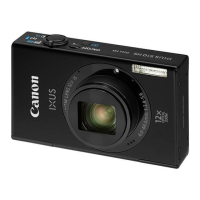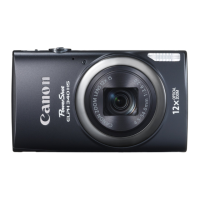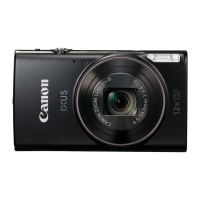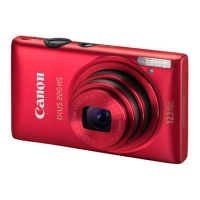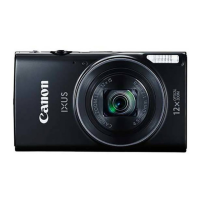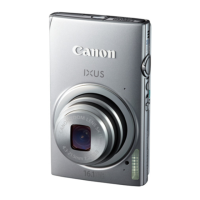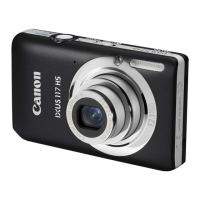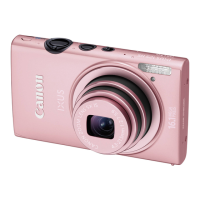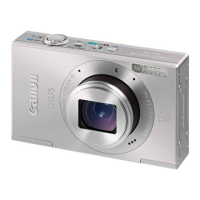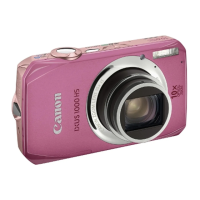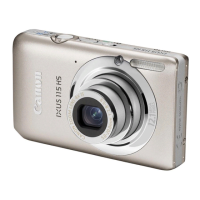Do you have a question about the Canon IXUS 230 HS and is the answer not in the manual?
Lists the items that should be included in the camera package upon purchase.
Provides essential information and warnings before operating the camera for the first time.
Details critical warnings and cautions to prevent injury, death, or equipment damage during camera use.
Provides advice on avoiding hazardous environments and proper handling to prevent damage.
Offers further safety instructions regarding battery handling, placement, and general care to prevent accidents.
Explains the correct method for attaching the camera strap and holding the camera securely while shooting.
Provides step-by-step instructions on how to charge the camera's battery pack using the included charger.
Details the expected battery life, shooting times, and indicators for battery charge status.
Lists the types of memory cards (SD, SDHC, SDXC, Eye-Fi) compatible with the camera.
Provides detailed instructions on how to correctly insert the battery and memory card into the camera.
Guides on closing the compartment cover and how to remove the battery and memory card.
Explains how to set the camera's date, time, and home time zone upon first use.
Details how to change the date and time settings and configure daylight saving time.
Explains the process of formatting a memory card before first use or when transferring between devices.
Details the final steps of memory card formatting and provides warnings about data erasure and disposal.
Explains the two-stage action of pressing the shutter button for focusing and capturing the image.
Describes how to use the Smart Auto mode for automatic scene detection and setting adjustment.
Covers the shooting process in Smart Auto and addresses common issues like unexpected colors or missing frames.
Addresses specific issues related to AF frames appearing in different colors and flash behavior during shooting.
Explains how to enter playback mode and navigate through captured still images using the camera buttons.
Details the process of selecting and permanently deleting images from the memory card.
Guides on selecting images for erasure, either individually, by range, or all at once.
Details the process of confirming and executing the erasure of selected images.
Guides on how to start and conduct movie recording, including microphone usage and button operations.
Covers how to stop movie recording and provides information on shooting times based on memory card capacity.
Explains how to select and play back recorded movie clips on the camera screen.
Lists the necessary system requirements for both Windows and Macintosh computers to install and use the transfer software.
Provides instructions for installing the necessary software from the CD-ROM onto a computer.
Details the process of connecting the camera to a computer and transferring images using the CameraWindow software.
Offers solutions for potential issues encountered during image transfer and outlines alternative transfer methods.
Identifies and explains the function of external parts of the camera, labeled with numbers.
Details camera buttons, controls, and the function of the mode switch for selecting shooting modes.
Details how to access and use the FUNC. menu for quickly adjusting commonly used camera settings.
Explains how to access and navigate through the camera's main menu to configure various functions.
Explains how to reset the camera's settings back to their original factory defaults.
Introduces the chapter's content on using common camera functions like the self-timer and flash control.
Guides on how to disable the camera's flash for shooting in situations where it is not needed.
Explains how to use the self-timer to include the photographer in group shots, with a 10-second delay.
Details how to customize the self-timer delay (0-30 seconds) and the number of shots (1-10).
Introduces the chapter on applying creative effects and shooting in diverse environmental conditions.
Explains how to select specific shooting modes tailored for different scenarios like portraits or kids/pets.
Covers scene modes for nightscapes, low light, beach, foliage, and snow conditions.
Details shooting modes for fireworks and provides notes on camera shake and ISO speed in various conditions.
Explains how to apply visual effects like vivid colors and poster effect to images while shooting.
Describes how to use the fish-eye lens effect and the miniature model effect for creative photography.
Explains how to apply the toy camera effect and adjust color tones for a vintage look.
Details how to shoot images in black and white, sepia, or blue and white tones.
Explains how to retain a single color while converting the rest of the image to black and white.
Describes how to swap one color in an image for another during the recording process.
Describes how to shoot continuously at high speeds (approx. 8.7 images/sec) by holding the shutter button.
Explains how to choose settings in Program AE mode to suit preferences and obtain correct exposure.
Explains how to shoot continuously at a speed of approximately 3.5 images/second.
Explains how to shoot various types of movies, including those with effects and specific scene modes.
Explains how to protect important images from being accidentally erased by the camera's erase function.
Details the process of selecting and protecting individual images from deletion.
Guides on connecting the camera to a PictBridge compliant printer for direct printing of photos.
Details the process of printing images and repeating steps for additional prints.
Details the process of low-level formatting for memory cards when issues arise.
Addresses common problems related to camera power, battery, and lens not retracting.
Provides solutions for issues like blurred images, incorrect focus, and grainy or overexposed pictures.
Covers troubleshooting for movie recording, playback errors, and memory card recognition problems.
Provides essential precautions for handling the camera to prevent damage and ensure longevity.
Lists the items that should be included in the camera package upon purchase.
Provides essential information and warnings before operating the camera for the first time.
Details critical warnings and cautions to prevent injury, death, or equipment damage during camera use.
Provides advice on avoiding hazardous environments and proper handling to prevent damage.
Offers further safety instructions regarding battery handling, placement, and general care to prevent accidents.
Explains the correct method for attaching the camera strap and holding the camera securely while shooting.
Provides step-by-step instructions on how to charge the camera's battery pack using the included charger.
Details the expected battery life, shooting times, and indicators for battery charge status.
Lists the types of memory cards (SD, SDHC, SDXC, Eye-Fi) compatible with the camera.
Provides detailed instructions on how to correctly insert the battery and memory card into the camera.
Guides on closing the compartment cover and how to remove the battery and memory card.
Explains how to set the camera's date, time, and home time zone upon first use.
Details how to change the date and time settings and configure daylight saving time.
Explains the process of formatting a memory card before first use or when transferring between devices.
Details the final steps of memory card formatting and provides warnings about data erasure and disposal.
Explains the two-stage action of pressing the shutter button for focusing and capturing the image.
Describes how to use the Smart Auto mode for automatic scene detection and setting adjustment.
Covers the shooting process in Smart Auto and addresses common issues like unexpected colors or missing frames.
Addresses specific issues related to AF frames appearing in different colors and flash behavior during shooting.
Explains how to enter playback mode and navigate through captured still images using the camera buttons.
Details the process of selecting and permanently deleting images from the memory card.
Guides on selecting images for erasure, either individually, by range, or all at once.
Details the process of confirming and executing the erasure of selected images.
Guides on how to start and conduct movie recording, including microphone usage and button operations.
Covers how to stop movie recording and provides information on shooting times based on memory card capacity.
Explains how to select and play back recorded movie clips on the camera screen.
Lists the necessary system requirements for both Windows and Macintosh computers to install and use the transfer software.
Provides instructions for installing the necessary software from the CD-ROM onto a computer.
Details the process of connecting the camera to a computer and transferring images using the CameraWindow software.
Offers solutions for potential issues encountered during image transfer and outlines alternative transfer methods.
Identifies and explains the function of external parts of the camera, labeled with numbers.
Details camera buttons, controls, and the function of the mode switch for selecting shooting modes.
Details how to access and use the FUNC. menu for quickly adjusting commonly used camera settings.
Explains how to access and navigate through the camera's main menu to configure various functions.
Explains how to reset the camera's settings back to their original factory defaults.
Introduces the chapter's content on using common camera functions like the self-timer and flash control.
Guides on how to disable the camera's flash for shooting in situations where it is not needed.
Explains how to use the self-timer to include the photographer in group shots, with a 10-second delay.
Details how to customize the self-timer delay (0-30 seconds) and the number of shots (1-10).
Introduces the chapter on applying creative effects and shooting in diverse environmental conditions.
Explains how to select specific shooting modes tailored for different scenarios like portraits or kids/pets.
Covers scene modes for nightscapes, low light, beach, foliage, and snow conditions.
Details shooting modes for fireworks and provides notes on camera shake and ISO speed in various conditions.
Explains how to apply visual effects like vivid colors and poster effect to images while shooting.
Describes how to use the fish-eye lens effect and the miniature model effect for creative photography.
Explains how to apply the toy camera effect and adjust color tones for a vintage look.
Details how to shoot images in black and white, sepia, or blue and white tones.
Explains how to retain a single color while converting the rest of the image to black and white.
Describes how to swap one color in an image for another during the recording process.
Describes how to shoot continuously at high speeds (approx. 8.7 images/sec) by holding the shutter button.
Explains how to choose settings in Program AE mode to suit preferences and obtain correct exposure.
Explains how to shoot continuously at a speed of approximately 3.5 images/second.
Explains how to shoot various types of movies, including those with effects and specific scene modes.
Explains how to protect important images from being accidentally erased by the camera's erase function.
Details the process of selecting and protecting individual images from deletion.
Guides on connecting the camera to a PictBridge compliant printer for direct printing of photos.
Details the process of printing images and repeating steps for additional prints.
Details the process of low-level formatting for memory cards when issues arise.
Addresses common problems related to camera power, battery, and lens not retracting.
Provides solutions for issues like blurred images, incorrect focus, and grainy or overexposed pictures.
Covers troubleshooting for movie recording, playback errors, and memory card recognition problems.
Provides essential precautions for handling the camera to prevent damage and ensure longevity.
| Sensor | 12.1 MP CMOS |
|---|---|
| Image Processor | DIGIC 4 |
| ISO Range | 100-3200 |
| Image Stabilization | Optical Image Stabilizer |
| Type | Compact digital camera |
| Digital Zoom | 4x |
| Image Sensor Size | 1/2.3 inch |
| Maximum Aperture | f/3.0 (W) - f/5.9 (T) |
| Lens | 8x optical zoom, 28-224mm equivalent |
| Display | 3.0-inch LCD |
| Video Recording | 1080p Full HD |
| Shutter Speed | 15-1/2000 sec |
| Dimensions | 95.8 x 56.8 x 21.9 mm |
| Battery | NB-4L Lithium-Ion |
